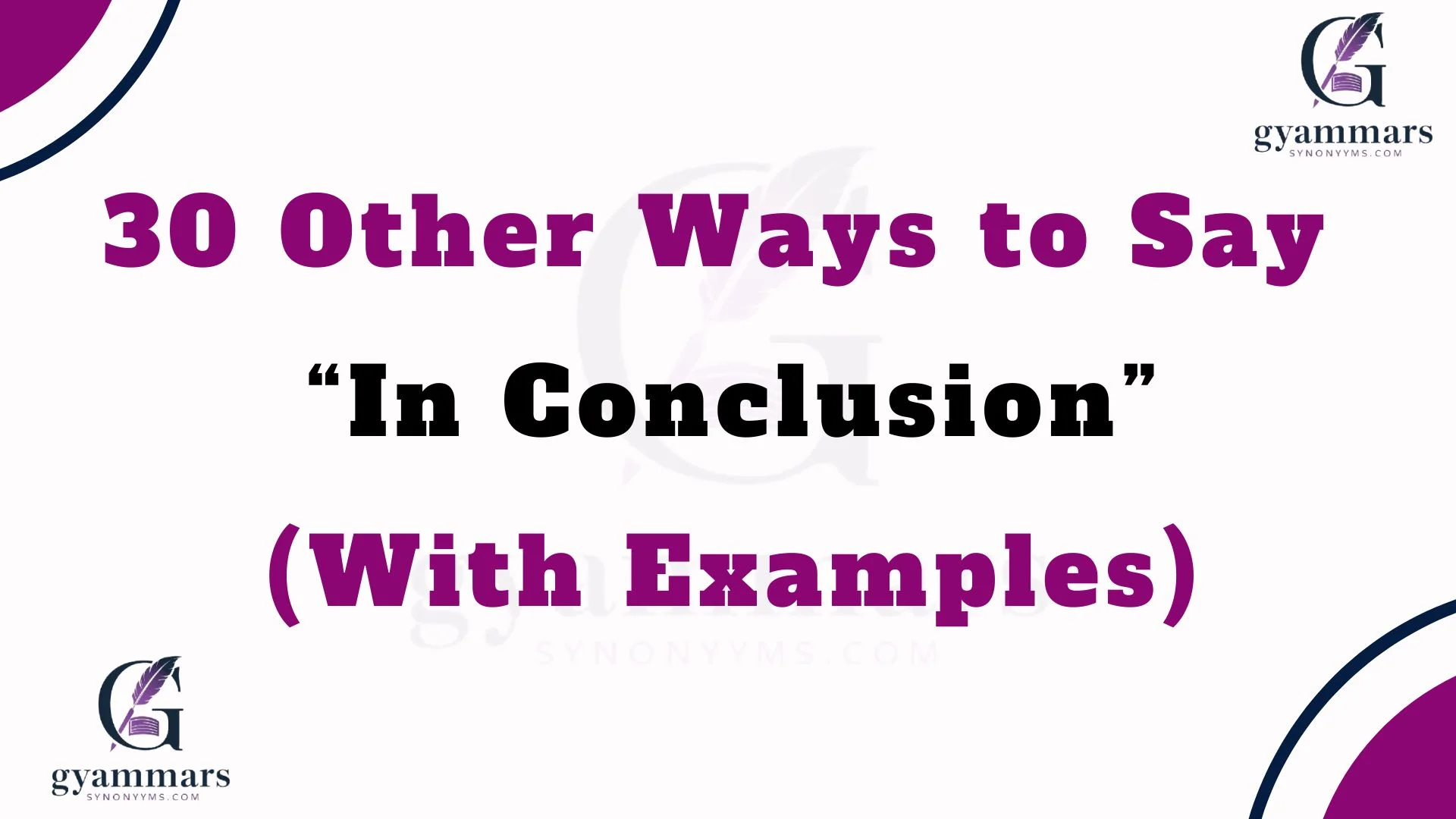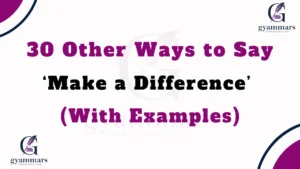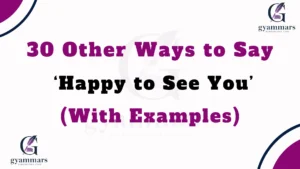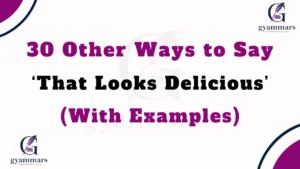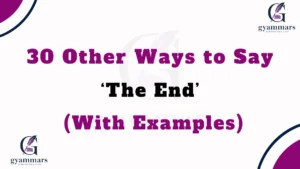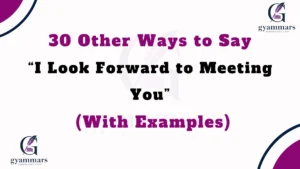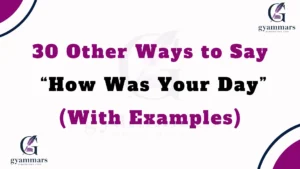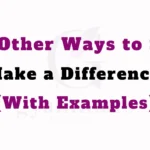Finding the perfect words to wrap up a conversation, speech, or piece of writing is more important than most people realize. Using the phrase “In Conclusion” repeatedly can feel stale or overly formal. By exploring alternative ways to say “In Conclusion,” you can make your message more personal, meaningful, and impactful, leaving a lasting impression on your audience.
What Does “In Conclusion” Mean?
Definition: “In Conclusion” is a transitional phrase used to signal the end of a discussion or presentation.
Detailed Explanation: It indicates to the audience that the speaker or writer is summarizing the main points.
Scenario Examples:
- In essays: “In conclusion, climate change requires urgent action.”
- In speeches: “In conclusion, I urge everyone to contribute to community service.”
Best Use: Formal writing, speeches, academic papers, or professional presentations.
Tone: Neutral, professional, and conclusive.
Additional Notes: Overuse can feel mechanical; alternatives can make your conclusion more engaging and warm.
Is It Professional/Polite to Say “In Conclusion”?
Yes, it is professional and polite when used in the right context. However, in casual conversations or informal writing, it might feel too rigid or stiff. Using alternatives can make your message feel more approachable and relatable while maintaining professionalism.
Pros and Cons
Pros:
- Clearly signals the end of content
- Creates a logical flow for readers/listeners
Cons:
- Can feel repetitive if overused
- May seem formal or impersonal in casual contexts
Synonyms For “In Conclusion”
- To Sum Up
- In Summary
- To Conclude
- In Closing
- Finally
- As a Final Point
- To Wrap Up
- In Brief
- In Essence
- To Recap
- As a Summary
- To Finish
- In Retrospect
- In Short
- To End
- As a Final Thought
- In Closing Remarks
- In the End
- In Final Analysis
- All Things Considered
- To Bring It All Together
- In a Nutshell
- To Recapitulate
- Overall
- On the Whole
- In Retrospective Summary
- To Round Off
- To Close
- In Final Thoughts
- As a Takeaway
1. To Sum Up
Definition: Summarizes key points concisely.
Detailed Explanation: Offers a brief recap of important ideas.
Scenario Examples: “To sum up, regular exercise improves both physical and mental health.”
Best Use: Casual to semi-formal writing.
Tone: Friendly, clear.
Additional Notes: Great for blog posts or casual presentations.
2. In Summary
Definition: A concise wrap-up of ideas.
Detailed Explanation: Focuses on summarizing content without adding new information.
Scenario Examples: “In summary, teamwork leads to better results in projects.”
Best Use: Reports, emails, academic papers.
Tone: Formal, professional.
Additional Notes: Works well for clarity and brevity.
3. To Conclude
Definition: Signals the end of a discussion.
Detailed Explanation: Similar to “In Conclusion,” but slightly more personal in tone.
Scenario Examples: “To conclude, our efforts will shape a better future.”
Best Use: Speeches, presentations, essays.
Tone: Neutral-professional.
Additional Notes: Versatile in both formal and semi-formal contexts.
4. In Closing
Definition: Marks the final thoughts of a statement.
Detailed Explanation: Commonly used in speeches or letters.
Scenario Examples: “In closing, thank you all for your dedication.”
Best Use: Speeches, emails, letters.
Tone: Polite, professional, warm.
Additional Notes: Friendly and slightly more personal than “In Conclusion.”
5. Finally
Definition: Introduces the last point or thought.
Detailed Explanation: Useful for emphasizing final remarks.
Scenario Examples: “Finally, don’t forget to submit your assignments on time.”
Best Use: Presentations, casual writing.
Tone: Casual-professional.
Additional Notes: Works best when listing multiple points before the conclusion.
6. As a Final Point
Definition: Highlights the last argument or idea.
Detailed Explanation: Signals importance and ensures the audience remembers this point.
Scenario Examples: “As a final point, collaboration is key to innovation.”
Best Use: Essays, reports, presentations.
Tone: Formal-instructive.
Additional Notes: Slightly more persuasive than “In Conclusion.”
7. To Wrap Up
Definition: Casual way to indicate the end.
Detailed Explanation: Common in blogs, informal emails, and conversations.
Scenario Examples: “To wrap up, our event was a huge success!”
Best Use: Casual-professional writing.
Tone: Friendly, approachable.
Additional Notes: Great for creating a warm and relatable closing.
8. In Brief
Definition: Offers a short summary.
Detailed Explanation: Condenses ideas into few words.
Scenario Examples: “In brief, our findings show positive trends in sales.”
Best Use: Reports, emails, formal documents.
Tone: Formal, concise.
Additional Notes: Perfect when readers need a quick takeaway.
9. In Essence
Definition: Captures the core idea.
Detailed Explanation: Focuses on the main message or underlying meaning.
Scenario Examples: “In essence, kindness drives meaningful relationships.”
Best Use: Professional writing, thought leadership.
Tone: Reflective, thoughtful.
Additional Notes: Slightly philosophical and engaging.
10. To Recap
Definition: Revisits the key points briefly.
Detailed Explanation: Helps reinforce important takeaways.
Scenario Examples: “To recap, teamwork, communication, and planning are essential.”
Best Use: Meetings, presentations.
Tone: Informative, professional.
Additional Notes: Great for reinforcing memory retention.
11. As a Summary
Definition: Another way to summarize ideas.
Detailed Explanation: Emphasizes the main points without new info.
Scenario Examples: “As a summary, our marketing strategy exceeded expectations.”
Best Use: Reports, academic papers.
Tone: Formal, concise.
Additional Notes: Works well for structured or analytical writing.
12. To Finish
Definition: Marks the end of discussion or speech.
Detailed Explanation: Signals final remarks in a friendly tone.
Scenario Examples: “To finish, I want to thank everyone for their hard work.”
Best Use: Semi-formal writing, presentations.
Tone: Warm, approachable.
Additional Notes: Casual alternative for less formal contexts.
13. In Retrospect
Definition: Reflects on past points or events.
Detailed Explanation: Combines summary with reflection.
Scenario Examples: “In retrospect, our decisions led to great outcomes.”
Best Use: Reflective essays, reports.
Tone: Thoughtful, reflective.
Additional Notes: Adds a personal touch to conclusions.
14. In Short
Definition: Simplifies main ideas.
Detailed Explanation: Good for providing concise conclusions.
Scenario Examples: “In short, the project achieved its goals.”
Best Use: Emails, casual writing.
Tone: Clear, friendly.
Additional Notes: Great for busy readers.
15. To End
Definition: Signals final remarks.
Detailed Explanation: Simple, direct, and clear.
Scenario Examples: “To end, I encourage everyone to participate actively.”
Best Use: Informal or semi-formal writing.
Tone: Casual, clear.
Additional Notes: Straightforward alternative to In Conclusion.
16. As a Final Thought
Definition: Offers a closing idea.
Detailed Explanation: Encourages reflection or action.
Scenario Examples: “As a final thought, remember to stay true to yourself.”
Best Use: Inspirational speeches, letters, or blogs.
Tone: Encouraging, reflective.
Additional Notes: Personal and thoughtful.
17. In Closing Remarks
Definition: Formal wrap-up statement.
Detailed Explanation: Often used in speeches or presentations.
Scenario Examples: “In closing remarks, I commend everyone’s efforts.”
Best Use: Professional settings.
Tone: Formal, respectful.
Additional Notes: Perfect for ceremonies and official events.
Also Read This : 30 Other Ways to Say “Netflix and Chill” (With Examples)
18. In the End
Definition: Conveys the final outcome or summary.
Detailed Explanation: Often used for reflection or storytelling.
Scenario Examples: “In the end, teamwork always triumphs.”
Best Use: Informal or narrative writing.
Tone: Casual, reflective.
Additional Notes: Adds a storytelling feel.
19. In Final Analysis
Definition: Evaluates and concludes based on reasoning.
Detailed Explanation: Summarizes findings or arguments.
Scenario Examples: “In final analysis, our approach was effective.”
Best Use: Reports, essays, academic writing.
Tone: Analytical, professional.
Additional Notes: Ideal for data-driven conclusions.
20. All Things Considered
Definition: Weighs everything discussed before concluding.
Detailed Explanation: Suggests a thoughtful, balanced final thought.
Scenario Examples: “All things considered, this strategy will benefit our team.”
Best Use: Essays, reports, reflective writing.
Tone: Reflective, thoughtful.
Additional Notes: Shows careful consideration.
21. To Bring It All Together
Definition: Combines ideas into a cohesive conclusion.
Detailed Explanation: Useful for connecting multiple points.
Scenario Examples: “To bring it all together, collaboration and planning drive success.”
Best Use: Speeches, workshops, presentations.
Tone: Clear, cohesive, professional.
Additional Notes: Great for structured, multi-point conclusions.
22. In a Nutshell
Definition: Very brief summary of key ideas.
Detailed Explanation: Often used to simplify complex ideas.
Scenario Examples: “In a nutshell, our campaign exceeded all expectations.”
Best Use: Casual writing, emails, blogs.
Tone: Friendly, light.
Additional Notes: Engaging, easy to read.
23. To Recapitulate
Definition: Another formal way to summarize points.
Detailed Explanation: Often used in academic or professional contexts.
Scenario Examples: “To recapitulate, we achieved all milestones successfully.”
Best Use: Formal reports, presentations.
Tone: Formal, professional.
Additional Notes: Less common, so it sounds polished and educated.
24. Overall
Definition: Provides general summary or impression.
Detailed Explanation: Highlights main outcomes or conclusions.
Scenario Examples: “Overall, the project was a huge success.”
Best Use: Casual-professional writing.
Tone: Neutral, friendly.
Additional Notes: Simple, versatile.
25. On the Whole
Definition: Summarizes broad perspective.
Detailed Explanation: Looks at the big picture rather than details.
Scenario Examples: “On the whole, our strategy worked well.”
Best Use: Analytical writing, reflections.
Tone: Balanced, thoughtful.
Additional Notes: Friendly and reflective.
26. In Retrospective Summary
Definition: Combines reflection with summary.
Detailed Explanation: Offers insight and recap together.
Scenario Examples: “In retrospective summary, we learned valuable lessons.”
Best Use: Personal essays, reports.
Tone: Thoughtful, reflective.
Additional Notes: Slightly formal yet personal.
27. To Round Off
Definition: Marks the final statement.
Detailed Explanation: Common in speeches and articles.
Scenario Examples: “To round off, I thank everyone for their dedication.”
Best Use: Speeches, informal-professional writing.
Tone: Friendly, polite.
Additional Notes: Casual alternative for warm closings.
28. To Close
Definition: Signals completion.
Detailed Explanation: Friendly and concise.
Scenario Examples: “To close, I encourage all of you to stay curious.”
Best Use: Blogs, casual presentations.
Tone: Warm, approachable.
Additional Notes: Very flexible and informal.
29. In Final Thoughts
Definition: Shares the last reflection.
Detailed Explanation: Often personal, reflective, or motivational.
Scenario Examples: “In final thoughts, always prioritize your well-being.”
Best Use: Inspirational writing, blogs.
Tone: Thoughtful, encouraging.
Additional Notes: Personalizes conclusions.
30. As a Takeaway
Definition: Highlights what readers or listeners should remember.
Detailed Explanation: Focuses on key lessons or actions.
Scenario Examples: “As a takeaway, invest time in building strong relationships.”
Best Use: Speeches, presentations, blogs.
Tone: Friendly, motivational.
Additional Notes: Emphasizes actionable insights.
Conclusion
Using alternatives to “In Conclusion” allows you to communicate your ideas more effectively and warmly. Whether you want a formal, professional tone or a friendly, approachable ending, choosing the right phrase can enhance how your audience receives and remembers your message. From casual expressions like “To Wrap Up” to formal ones like “To Recapitulate”, these alternatives provide flexibility, clarity, and personality in your communication.
FAQs about Moja is Artificial
1. What does “Moja is Artificial” mean?
It usually refers to something that isn’t natural and is man-made, designed, or created using technology or artificial intelligence.
2. Is Moja related to Artificial Intelligence (AI)?
Yes, the phrase is often connected with AI or artificial systems that simulate human-like creativity, communication, or behavior.
3. Why do people say Moja is artificial?
Because it highlights the difference between natural originality and machine-generated or synthetic creations.
4. Can artificial systems like Moja replace human creativity?
Artificial systems can assist, speed up, and inspire creative work, but they don’t fully replace human imagination, emotions, and originality.
5. What are the benefits of something being artificial?
Artificial systems are faster, more efficient, and consistent. They help in writing, designing, problem-solving, and reducing human workload.

“Emma Brooke at Grammar Synonyms is your trusted source for mastering the art of language. Whether you’re looking for the perfect synonym, refining your grammar, or searching for that one ideal phrase, we’ve got you covered. With a wealth of tools and resources, Emma Brooke brings you creative solutions for all your writing needs, making sure your words always hit the mark. Unlock a world of language possibilities and elevate your writing with ease.”
